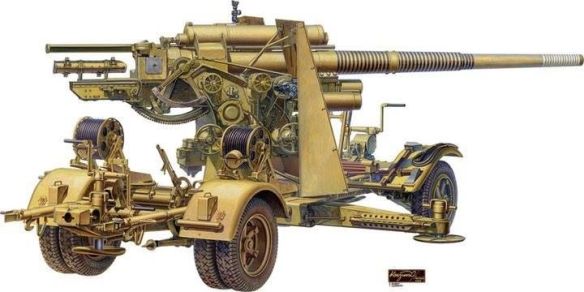
This gun was the 8.8-cm Flak 18 (Flak standing for Fliegerabwehrkanone, or anti-aircraft gun), and it was an immediate success. It was a long-barrelled gun mounted on a pivoted cruciform carriage which was in turn carried on the move by twin axles that allowed the gun to be rapidly placed into the firing position. The Flak 18 had a one-piece barrel but was later supplemented by an improved version, the 8.8-cm Flak 36, which had a multisection barrel on which only the worn part nearest the chamber needed to be changed after prolonged firing. Then came the 8.8-cm Flak 37, which was a Flak 36 with a revised system of fire-control data transmission more suited to static use than field use, In practice the three models were interchangeable to a high degree, and it was not unusual to see a Flak 18 barrel on a Flak 37 carriage. Several changes were introduced to the weapons once they were in service, including a revised twin-axle carriage arrangement, and the 8.8-cm Flak series was adapted to be carried on a variety of self-propelled mountings, including railway flatcars.
The 8.8-cm Flak series became one of the most celebrated weapons in the entire German army, for it went on to be as famous as an anti-tank weapon as it was as an anti-aircraft gun: following the gun’s ‘blooding’ in Spain during the Civil War and again in France in 1940, it was discovered that the high muzzle velocity coupled with an efficient and heavy projectile made the weapon ideal as a ‘tank killer’. This became very evident during the early North African and later Eastern Front campaigns, but the 8.8-cm Flak series was really too high and bulky for the antitank role and had to rely on its range and power rather than concealment in action.
Specification 8.8-cm Flak 18 Calibre: 88 mm (3.465 in) Weight: travelling 6861 kg (15,126 lb) and firing 5150 kg (11,354 lb) Dimensions: length overall 7.62 m (25 ft 0 in); width 2.305 m (7 ft 6.75 in); height 2,418 m (7 ft 11.2 in); length of barrel 4,93m(16ft2.1 in); length of rifling 4.124 m (13 ft 6.4 in) Elevation: +85 to -3° Traverse: 360° Maximum ceiling: 8000 m (26,245 ft) Shell weight: HE 9.24 kg (20,34 lb) Muzzle velocity: 820 m (2,690 ft) per second
The SdKfz 7 mittlerer Zugkraftwagen 8t had its origins in a series of Kraus- Maffei design projects that dated back as far as 1928, but it was not until an army staff requirement for an 8-tonne halftrack tractor was made in 1934 that development really got under way. Between 1934 and 1938 a number of trial versions were produced until the final version appeared in 1938 as the SdKfz 7 mittlerer Zugkraftwagen. This vehicle earned its primary fame as the main tractor for the well-known 8.8-cm (3.46-in) Flak 18, 36 and 37 guns, but it was also used as a tractor for many other artillery weapons including the 15-cm (5.9-in) sFH 18 and the 10.5-cm (4,13-in) K 18.
In its tractor form the SdKfz 7 could carry up to 12 men and their kit, and there was still space left for ammunition and/or other supplies. The gun detachment sat on open bench seats behind the driver, and could be covered by a canvas tilt to keep out some of the weather. The vehicle could tow weights up to 8000 kg (17,637 lb), and most vehicles were fitted with a winch that could pull up to 3450 kg (7,606 lb), The SdKfz 7 proved to be a most useful vehicle and was widely admired, A captured example was copied in the United Kingdom by Bedford Motors with a view to manufacture for Allied use, and the Italian produced a near-copy known as the Breda 61. But the Germans carried on churning out as many as they could. By the end of 1942 there were 3,262 in service. Not all of these were tractors, for the load-carrying capacity of the SdKfz 7 was such that it also made an ideal weapon platform.
Specification SdKfz 7 Crew: 12 Weights: 11550 kg (25,463 lb) Powerplant: one Maybach HL 62 6- cylinder petrol engine developing 104.4kW (140 hp) Dimensions: length 6.85 m (20 ft 3 in); width 2.40 m(7 ft 10.5 in); height 2.62 m (8 ft 7.1 in) Performance: maximum road speed 50 km/h (31 mph)